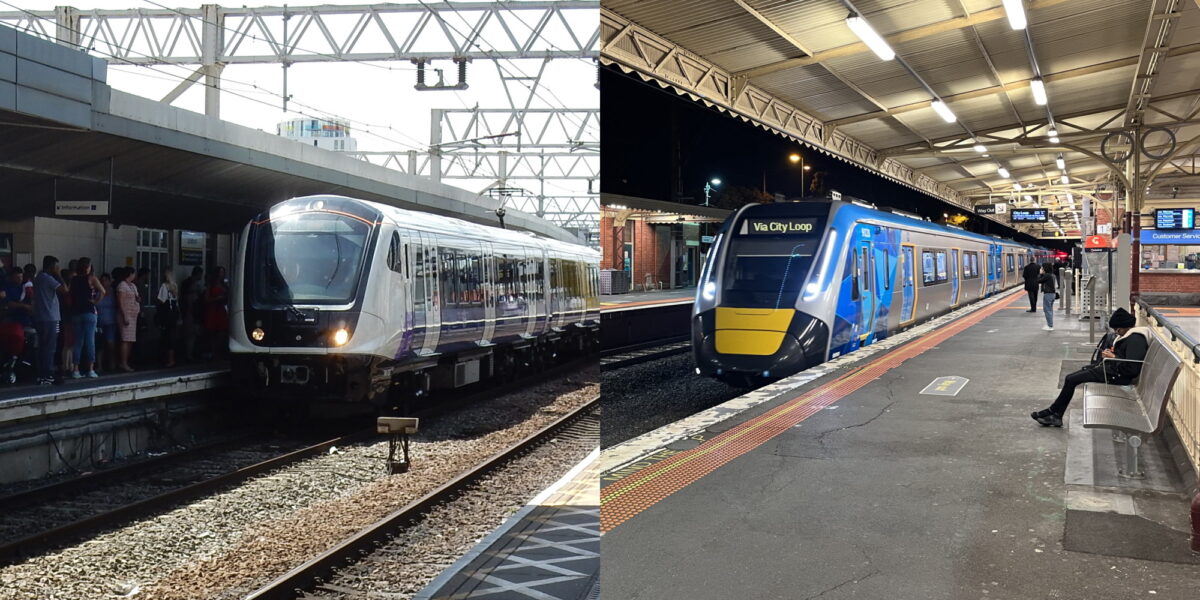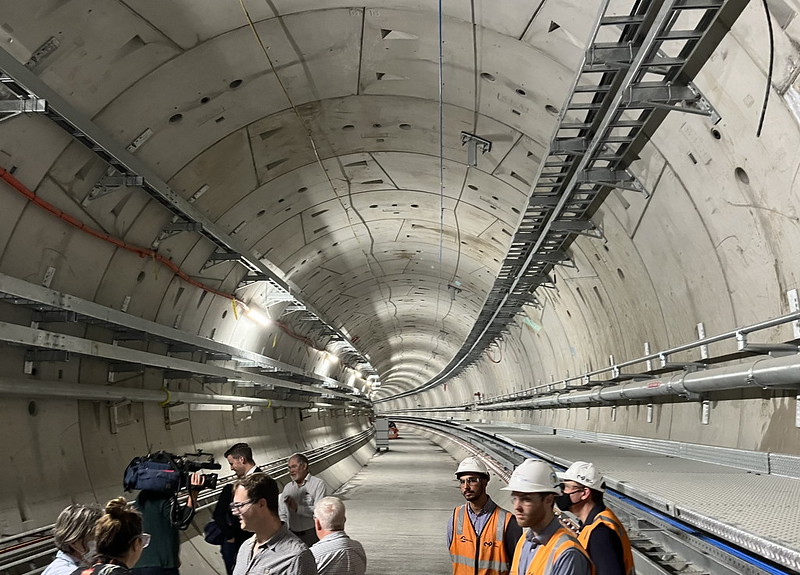Back in the Mother Country, they just opened the new rail line across central London. Known as Crossrail during construction, it’s officially now called the Elizabeth Line.
In an article in the Australian Financial Review, Crossrail CEO (and former PTV CEO) Mark Wild compared Crossrail with two of the biggest Australian rail projects: the Melbourne Metro tunnel and Sydney Metro.
He noted that the real problems began when they started integrating the new signalling systems, and in particular where the new has to interface with the old.
Melbourne Metro in particular has a number of similarities to Crossrail: they’re both central city rail tunnels connecting existing lines, with the aim of adding capacity and cutting travel times.
So I thought I’d do a quick comparison.
| Project | London Crossrail | Melbourne Metro Tunnel |
| Brief description | New central rail tunnel connected to existing lines | New central rail tunnel connected to existing lines |
| Tunnel length | 2 x 21 km | 2 x 9 km |
| New stations | 10: Paddington Bond Street Tottenham Court Road Farringdon Liverpool Street Whitechapel Canary Wharf Custom House Woolwich Abbey Wood | 5 – all underground: Arden Parkville State Library Town Hall Anzac Plus East Pakenham, opening 2024 (technically part of a separate project) |
| Interchange stations | All 10 provide interchange to existing lines All named for their existing interchange stations | Interchange at State Library (to Melbourne Central) and Town Hall (to Flinders Street) Stations were given brand new names |
| New development precincts | None that I can see? | Arden |
| Total route length including existing line | 118 km | 111 km |
| Total stations | 41 | 41 (including East Pakenham) |
| Platform screen doors | At new stations in central London | At the new underground stations |
| Outer branches | 4: Reading and Heathrow airport (west) to Abbey Wood and Shenfield (east) (5 if you count the Heathrow branches separately) | 3: Sunbury (west) to Cranbourne and Pakenham (east) (4 once Melbourne Airport rail opens) |
| High capacity signalling | Yes, multiple systems depending on the section (Source: Crossrail: What’s the hold-up?) | Watergardens to Dandenong using Bombardier CITYFLO 650 (See also: Marcus Wong’s blog on HCS) |
| Shared tracks | Heathrow branch, sharing with Heathrow Express trains (Not sure about others; it looks like the new line takes over from most other existing stopping services to Reading, Abbey Wood, Shenfield) | Sunbury to Sunshine – V/Line South Yarra to Pakenham – V/Line and freight |
| Expected opening | 2022 Initial opening 2023 Completion | 2025 |
| Cost | £18.9 bn (approx A$33.6 bn) (Source) | A$12.4 bn (Source) |
| Fleet | 70 x 9-car Class 345 trains | 65 x 7-car Evolution HCMTs Future expansion to 10-cars |
| Initial service frequency | Paddington – Reading or Heathrow: about every 10-15 minutes Paddington – Abbey Wood: every 5 mins (6am to 10pm Mon-Sat) – Sunday service coming later Liverpool St – Shenfield: every 6-8 mins (6am to 10pm Mon-Sat), every 15 mins (Sundays) (Source: Timetables) | Sunshine – Dandenong: about every 4 mins (peak), every 10-20 mins (off-peak)* (Source: the Metro Tunnel Business Plan, Proposed Service Plan (2016), which the government subsequently said was a base case, not a service plan… even though it’s called a Proposed Service Plan.) |
| Eventual frequency | Up to 24 trains per hour | Not clear, but probably similar given the deployment of high capacity signalling |
Corrections and additions very welcome.
It’s not just the concepts that are similar. The total route length and number of stations, the fleet size are all very similar.
But a key difference (which probably accounts for a lot of the cost) is longer tunnels and more new stations on the Elizabeth Line. It’ll also run a lot more trains, particularly outside peak times.
Hopefully the Melbourne Metro actual service levels turn out to be far better than the rather sad off-peak frequencies (to the west at least) flagged in the Proposed Service Plan – especially given how important it is post-COVID to provide for all kinds of journeys, not just peak trips.
The recent funding for recruitment of “over 100” additional train drivers is a good sign.
Mark Wild’s warning about mixing signalling systems is relevant – V/Line and freight trains will run through the sections where the Metro trains are using the High Capacity Signalling. After testing started on the Mernda line, it’s now happening on the Cranbourne/Pakenham line.
Hopefully the right people are working on it (Wild mentioned some of his team had headed to Australia as Crossrail wound down), and the rest of the project goes smoothly.
I may not get to London soon to see Crossrail while it’s new, but I am definitely looking forward to catching a train through the new Melbourne Metro Tunnel in 2025.
- Lead image (left hand side): Elizabeth Line train at Stratford, by Sunil060902 via Wikipedia – image modified
- Friday at 6pm the PTUA is hosting a member meeting with James C Murphy, author of a new book about East West Link


15 replies on “Comparing Crossrail and the Metro tunnel”
Hey Daniel,
Great article as usual. I noticed yesterday in the rollingstock strategy that it now seems that there’s 5 more HCMTs incoming for the airport line. Just wondering if it makes sense to note for the Airport comparison. It also makes it quite interesting that this would mean that both tunnels will have 70 trains committed (capacity on the Elizabeth line would be a lot higher though).
https://www.downergroup.com/Melbourne’s%20largest%20single%20train%20order%20just%20got%20bigger
Hi Daniel
Thanks for an interesting article. What is the international equivalent (if there is one) for the Suburban Rail Loop? Is it the Singapore Circle line?
Excellent article and nice comparison! For the Crossrail, while new development precincts may not be evident, I believe there has been a lot of redevelopment occurring in the areas immediately near the new stations. I’m sure this has been spurred by the new line and in particular, the ease of getting to these parts from Heathrow.
Both lines have a station called Tottenham – another similarity!
Assuming electrification to Wyndham Vale and Melton, which would give four metropolitan branches past Sunshine, what would happen towards the city? Electrification of the RRL tracks through to Southern Cross, using the Metro Tunnel to connect to the Dandenong line, connecting to the existing Sunbury line tracks through North Melbourne and the City Loop, or another option, or a combination? A 10-minute service to each of the four branches would be 24 trains per hour through the Sunshine corridor to the Metro Tunnel.
The comparison is interesting. What excitement there was of the opening of the Elizabeth Line. It would be good for PTV and Metro to create a similar atmosphere for the tunnel opening. Crossrail cost a lot of money but it was more complex than our tunnel.
I hadn’t been in the Metro Tunnel shop in Swanston Street since Covid began but I went in last week to see what was new and what was new was information about the Geelong rail project, whereby some Geelong trains will travel along the old route but on high speed tracks. I felt like writing about it, but realised I did not know enough. I’d love it if you wrote about the project.
PS I hate the name of our to be nearby Anzac Station. Domain or St Kilda Road would have been good.
Interesting post Daniel. Although aren’t the shared tracks down from Caulfield, and not South Yarra?
It would be interesting to know what the author says about Sydney Metro. The article is paywalled. I’m not sure that Sydney Metro is directly comparable as it doesn”t connect with other lines or services.
@Tom, good question, I’ll give it some thought. I know the Vic Govt has compared it to some including London’s Overground, which is also kind of an orbital line, but definitely not built from scratch like SRL.
@Anthony, thanks – not surprised it has sparked development, but yes not quite the same as the nearly blank slate that’s at Arden.
@Steve, yes you’re right, WV, Melton, Sunbury and Airport all feeding into the metro tunnel would start to crowd it, though that’s precisely what HCS is provided for.
@Andrew, the Geelong project is an interesting one. I did touch on it in posts in 2019 and 2020 but it’s worth a re-visit as more info emerges.
@Gobillino, the tunnel has no station at South Yarra, but it’s there (at the “Eastern portal”) that the trains from the tunnel will have to merge with V/Line and freight trains.
@Tony P, the article mostly focuses on the challenges of combining signalling systems. As such I agree, the Metro Tunnel is a more relevant project than the Sydney Metro, given the latter is completely independent, and can presumably be built with a single signalling system.
I keep wondering what’s going to happen to the tracks currently being used by the Sunbury line between the future western portal and North Melbourne after the future line seems to go through the Metro Tunnel. Would be nice if this becomes a start of a future new line.
@arfman – the tracks from North Melbourne platform 3 and 4 as far as North Melbourne Junction will remove conflicting moves between the Craigieburn and Upfield lines, which just leaves a rump between Moonee Ponds Creek and South Kensington as “unused”.
Will the trains still be stopping at south Yarra or going straight to Anzac station?
@Joel, no. The tracks enter the tunnel portal at South Yarra without providing a platform to stop there.
What an excellent idea to compare the London tunnel project with humble Melbourne’s tunnel. Fascinating comparisons!
I’m not sure how beneficial the new tunnel will be if you don’t live on the Dandenong-Sunbury(?) line. I think for me (Sandy line) it will be quicker and avoid rail-interchanges to go direct to Flinders St and catch a tram to the new stations (Town Hall, Parkville, etc). Or have I missed something?
@Roger The project will increase capacity through the “core” of our network (Flinders St to SXS viaduct and city loop) by adding tracks. This is supposed to allow more trains to be run on other lines and allow further segregation of the network.